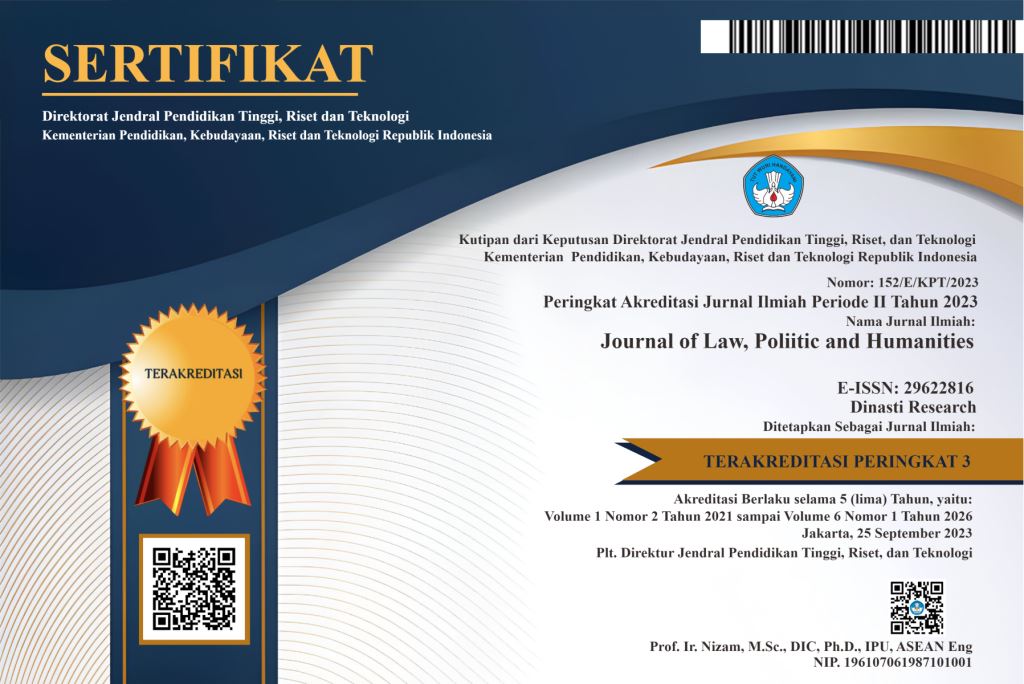Employing Poland's Military Depolitization and Professionalism As Security Sector Reform Strategy For Indonesia
DOI:
https://doi.org/10.38035/jlph.v4i5.514Keywords:
Poland, Indonesia, Military Reform, Civil-Military Relations, Military DepoliticizationAbstract
This article examines the reform of Poland’s security sector and its relevance for Indonesia. The study focuses on the depoliticization and professionalization of the Polish military. Depoliticization aims to remove political party influence from the military and ensure civilian control over strategic and defense decisions. This involves reducing political roles within the military, reforming military education, and establishing an independent legal framework. Professionalization has been achieved by modernizing technology and weaponry, enhancing soldier skills to meet NATO standards, and participating in joint exercises with NATO allies. These efforts have improved the effectiveness and efficiency of the Polish military in maintaining national security and regional stability. Using qualitative methods and Creswell’s comparative study approach, the research highlights how Poland’s experience can guide Indonesia in its military reforms. By integrating depoliticization and professionalization strategies inspired by Huntington and Stephan, the article provides a framework to accelerate and improve military reform in Indonesia.
References
Adim Pradana, H., & Inayah Ramadhoan, R. (2022). Strategi Konfrontatif NATO Terhadap Rusia di Negara-Negara Baltik dan Polandia. Jurnal Ilmiah Hubungan Internasional Fajar, 1(1), 1–14. https://doi.org/10.47354/jiihif.v1i1.438
Armed Forces. (2023). Polish Armed forces. https://armedforces.eu/Poland
Barrie, D., & Barry, B. (2019). Defending Europe: scenario-based capability requirements for NATO’s European members. International Institute for Strategic Studies. https://www.iiss.org/research-paper//2019/05/defending-europe
Béraud-Sudreau, L., & Giegerich, B. (2018). NATO Defence Spending and European Threat Perceptions. Survival Global Politics and Strategy, 60(4), 53–74. https://doi.org/10.1080/00396338.2018.1495429
Biden, J. R., & Carpenter, M. (2018). the Kremlin How to Stand Up to Defending Democracy Against Its Enemies. 97(1), 51–57.
Boston, S., Johnson, M., Nathan, B.-M., & Crane, Y. K. (2018). Assessing the Conventional Force Imbalance in Europe: Implications for Countering Russian Local Superiority. RAND Corporation. https://www.rand.org/pubs/research_reports/RR2402.html
Busza, E. (1996). Transition and Civil-Military Relations in Poland and Russia. 29(2), 167–184.
Buzek, J. (2009). The transformation of Poland since 1989. European View, 8(2), 187–190. https://doi.org/10.1007/s12290-009-0103-9
Calmels, C. (2020). NATO ’ s 360-degree approach to security?: alliance cohesion and adaptation after the Crimean crisis. https://doi.org/10.1080/09662839.2020.1795834
Chappell, L. (2010). Poland in transition: Implications for a European security and Defence policy. Contemporary Security Policy, 31(2), 225–248. https://doi.org/10.1080/13523260.2010.491312
Cie?lak, E. (2019). Poland’s Armed Forces in NATO, Two decades of transformation. Defense & Strategy, 19(1), 23. https://doi.org/10.3849/1802-7199.19.2019.01.023-038
Cottey, A. (1995). East-Central Europe after the Cold War Poland, the Czech Republic, Slovakia and Hungary in Search of Security. Macmillan Press. https://doi.org/10.1057/9780230374201
Croissant, A., Kuehn, D., & Lorenz, P. (2012). Breaking With the Past? Civil-Military Relations in the Emerging Democracies of East Asia. (Issue 63). East-West Center.
Dariusz, K. (2020). Polish armed forces in NATO multinational operations?: strategic threats or chances? In R. H. E (Ed.), Alliance planning and coalition warfare?: historical and contemporary approaches (pp. 242–257). Belgrad?: Institute for Strategic Research.
De Maio, G. (2021). Opportunities to deepen NATO-EU cooperation. Brookings Institution. https://www.brookings.edu/wp-content/uploads/2021/ 12/FP_20211203_ nato_eu_ cooperation_demaio.pdf
Dudek, A. (2014). The Consequence of the System transformation of 1989 in Poland. https://enrs.eu/article/the-consequence-of-the-system-transformation-of-1989-in-poland
Fields, F. E., & Jensen, J. J. (1998). Military professionalism in post?communist Hungary and Poland, An analysis and assessment.
Gilliam, J. B., & Van Wie, R. C. (2022). Feasible US steps to strengthen NATO deterrence in the Baltics and Poland. https://www.brookings.edu/wp-content/uploads/2022/03/FP_20220322_nato_ deterrence_ gilliam_van_wie.pdf
Giraldo, J. K. (2021). Defense budgets, democratic civilian control, and effective governance. In Who guards the guardians and how. University of Texas Press. https://doi.org/10.7560/712782-010
Global Fire Power. (2023). Poland Military Strength. https://www.globalfirepower.com/country-military-strength-detail.php?country_id=poland
Huntington, S. P. (1957). The Soldier and The States: The Theory and Politics of Civil-Military Relations. In Professional Ethics, A Multidisciplinary Journal (Vol. 10, Issue 2). Belknap Press of Harvard University Press. https://doi.org/10.5840/profethics2002102/3/418
Jermalavi?ius, T., Janeli?nas, T., Gotkowska, J., Järvenpää, P., Vanaga, N., & Szymanski, P. (2018). NATO‘s Northeast Quartet: Prospects and Opportunities for Baltic-Polish Defence Cooperation.
K?íž, Z., Brajer?íková, S., & Urbanovská, J. (2018). Defense Co-Operation Between Germany and the Visegrad Countries. The Journal of Slavic Military Studies, 31, 354–371.
Linz, J. J., & Stepan, A. (1996). Problems of Democratic Transition and Consolidation. The Johns Hopkins University Press.
Ministry of National Defence Republic of Poland. (2019). Poland in NATO - more than 20 years. https://www.gov.pl/web/national-defence/poland-in-nato-20-years
Muzeum Wojsk Ladowych. (2023). Polish Land Forces from 1945. https://muzeumwl.pl/en/polish-land-forces-from-1945/
NATO. (2001). Reforming Poland’s Military. https://www.nato.int/docu/review/articles/2001/06/01/reforming-poland-s-military/index.html.
Poland Government. (2021). Integrated Country Strategy?: Poland. In European University Institute. https://www.state.gov/wp-content/uploads/2021/03/ICS_EUR_Poland_Public-Release.pdf
Sari, M. R., & Kautsar, M. H. (2021). Comparative Analysis of Strategic Management in Defense Planning for Indonesia and Poland. Jurnal Pertahanan: Media Informasi Ttg Kajian & Strategi Pertahanan Yang Mengedepankan Identity, Nasionalism & Integrity, 7(3), 462. https://doi.org/10.33172/jp.v7i3.1487
SIPRI. (1990). World armaments and disarmament: SIPRI yearbook 1988. In International Affairs (Vol. 66, Issue 1). Oxford University Press. https://doi.org/10.2307/2622301
Solarin, S. A. (2018). Determinants of military expenditure and the role of globalisation in a cross-country analysis. Defence and Peace Economics, 29(7), 853–870. https://doi.org/10.1080/10242694.2017.1309259
Swierczynski, M. (2022). Making Poland’s Military Great Again. https://balkaninsight.com/2022/02/08/making-polands-military-great-again/
The Online Tank Museum. (2023). Tank Encyclopedia. https://www.tanks-encyclopedia.com/coldwar/Poland/cold-war-polish-tanks.php
Trading Economics. (2022). Poland Military Expenditure. https://tradingeconomics.com/poland/military-expenditure
Visegrad. (2021). About the Visegrad Group. https://www.visegradgroup.eu/about
Wiatr, J. J. (1967). Military Professionalism and Transformations of Class Structure in Poland. The Polish Sociological Bulletin, 16(16), 81–88.
Downloads
Published
How to Cite
Issue
Section
License
Copyright (c) 2024 Fathomi Abdillah Safi

This work is licensed under a Creative Commons Attribution 4.0 International License.
Authors who publish their manuscripts in this journal agree to the following conditions:
- The copyright on each article belongs to the author(s).
- The author acknowledges that the Journal of Law, Poliitic and Humanities (JLPH) has the right to be the first to publish with a Creative Commons Attribution 4.0 International license (Attribution 4.0 International (CC BY 4.0).
- Authors can submit articles separately, arrange for the non-exclusive distribution of manuscripts that have been published in this journal into other versions (e.g., sent to the author's institutional repository, publication into books, etc.), by acknowledging that the manuscript has been published for the first time in the Journal of Law, Poliitic and Humanities (JLPH).


























